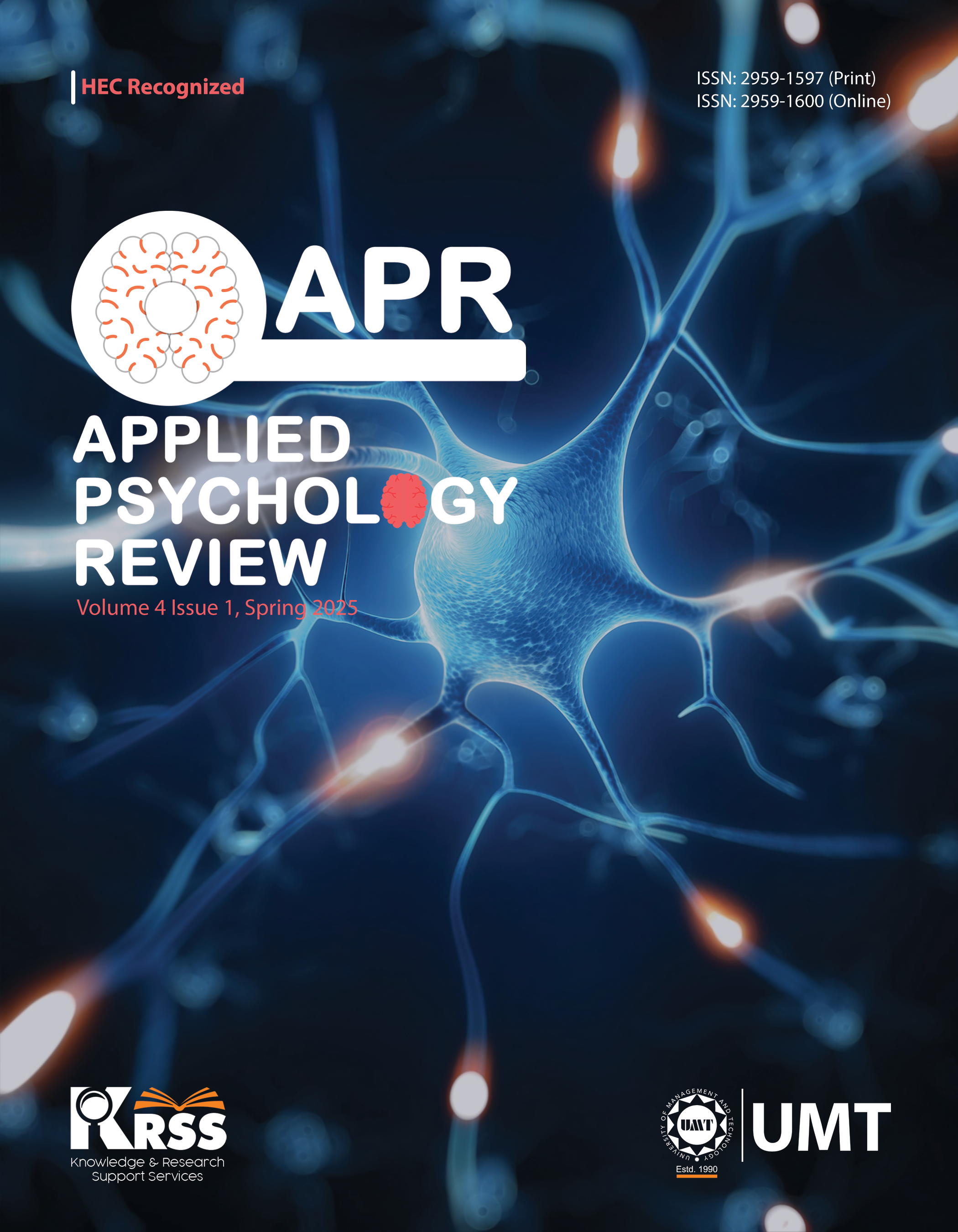Stress, Coping and Premenstrual Dysphoric Disorder in Young Pakistani Female Students
Abstract
 Abstract Views: 0
Abstract Views: 0
The present research aimed to identify the mediating relationship between stress, coping and premenstrual dysphoric symptoms experienced by university students. A correlational research design was employed in this study. Data was collected from 15 different departments of public university. The sample consisted of 300 female students (18 to 25 years, M = 21, SD=1.16) who were experiencing symptoms of Premenstrual Dysphoric Disorder (PMDD). They were selected through purposive sampling. The Student Stress Inventory, Brief COPE and PMDD symptom tracker were employed to measure the perceived stress level, coping strategy, severity of PMDD symptoms in female university students. Correlation and regression analysis were conducted. Results of the study showed a positive relationship between stress and PMDD symptoms. Avoidant coping and PMDD symptoms were found to have a strong relationship. Coping partially mediates the relationship between stress and PMDD symptoms, highlighting its role in reducing symptom severity under high stress levels. Findings suggest that interventions targeting stress management and adaptive coping strategies may help alleviate PMDD symptoms and inform future research on tailored therapeutic approaches.
Downloads
References
Akın, Ö., & Erbil, N. (2023). Investigation of coping behaviors and premenstrual syndrome among university students. Current Psychology, 43, 1685–1695. https://doi.org/10.1007/s12144-023-04419-1
Alwafa, R. A., Badrasawi, M., & Haj Hamad, R. (2021). Prevalence of premenstrual syndrome in college going girls – A cross-sectional study. BMC Women's Health, 21(1), Article e13746. https://doi.org/10.1186/s12905-021-01374-6
American Psychiatric Association. (2022). Diagnostic and statistical manual of mental disorders (5th ed.). American Psychiatric Publishing.
American Psychological Association. (2015). Stress in America: A national mental health crisis. https://www.apa.org/news/press/releases/stress/2020/report-october
Arif, A. (2013). Premenstrual syndrome symptoms (PMS) and prevalence among university students in Karachi, Pakistan. International Research Journal of Pharmacy, 4(4), 113–116. https://doi.org/10.7897/2230-8407.04425
Arip, M. M., Kamaruzaman, D. N., Roslan, A., Ahmad, A., Rahman, M. A., & Malim, T. (2015). Development, validity, and reliability of student stress inventory (SSI). The Social Sciences, 10(7), 1631–1638.
Atim, E., Okecho, F. N., Ndagire, R., & Lwanira, C. N. (2022). Effects and coping mechanisms associated with premenstrual syndrome among female university students in Central Uganda: A cross-sectional study. Scientific Journal of Humanities and Social Sciences, 3(9), Article e219. https://doi.org/10.51168/sjhrafrica.v3i9.219
Carver, C. S. (1997). You want to measure coping but your protocol's too long: Consider the brief COPE. International Journal of Behavioral Medicine, 4(1), 92–100.
Delelegn, T., & Getachew, Y. (2019). Premenstrual dysphoric disorder and associated factors among female health science students in Wollo University, Ethiopia. Maternal Health, Neonatology and Perinatology, 5(4), 67–78. https://doi.org/10.1186/s40748-019-0112-2
Eshetu, N., Abebe, H., Fikadu, E., Getaye, S., Jemal, S., Geze, S., Mesfin, Y., Abebe, S., Tsega, D., Tefera, B., & Tesfaye, W. (2022). Premenstrual syndrome, coping mechanisms and associated factors among Wolkite University female regular students, Ethiopia, 2021. BMC Women's Health, 22(1), Article e88. https://doi.org/10.1186/s12905-022-01658-5
Eisenlohr-Moul, T. (2019). Premenstrual disorders: A primer and research agenda for psychologists. The Clinical Psychologist, 72(1), Article e5. https://pmc.ncbi.nlm.nih.gov/articles/PMC7193982/
Folkman, S., & Moskowitz, J. T. (2004). Coping: Pitfalls and promise. Annual Review of Psychology, 55, 745–774. https://doi.org/10.1146/annurev.psych.55.090902.141456
Gupta, P., De, N., Hati, S., Saikia, C., & Karmakar, R. (2019). The relationship between positive psychological capital and coping styles: A study on young adults. Psychology, 10(12), 1649–1662. https://doi.org/10.4236/psych.2019.1012109
Hameed, M., & Fatima, M. (2022). The effect of perceived stress and body mass index on premenstrual dysphoric disorder among female university students. Life and Science, 3(4), Article e5. https://doi.org/10.37185/lns.1.1.227
Hardy, C., & Hunter, M. (2021). Premenstrual symptoms and work: Exploring female staff experiences and recommendations for workplaces. International Journal of Environmental Research and Public Health, 18(7), Article e3647. https://doi.org/10.3390/ijerph18073647
Ijaz, M. A., Ijaz, A., & Ijaz, M. M. (2023). Prevalence of anxiety, stress and depression symptoms in university students of south Punjab: Its relationship with socioeconomic factors. Pakistan Journal of Medical Research, 62(3), 112–116.
Jones, P. J., Park, S. Y., & LefeSouthvor, G. T. (2018). Contemporary college student anxiety: The role of academic distress, financial stress, and support. Journal of College Counseling, 21(3), 252–264. https://doi.org/10.1002/jocc.12107
Kalsoom, U., Sultana, A., Amjad, T., & Bairam, S. (2018). Prevalence of premenstrual syndrome and knowledge assessment regarding its prevention among medical students of a private medical college of Islamabad. Pakistan Armed Forces Medical Journal, 68(1), 159–164.
Madhavi, P., & Reddy, B. S. (2022). Appraisal-focused coping style among adolescent girls: Role of anxiety, depression and personality. International Journal of Indian Psychology, 7(3), Article e035. https://doi.org/10.25215/0703.035
Ozimek, N., Velez, K. M., Anvari, H., Butler, L., Goldman, K. N., & Woitowich, N. C. (2022). Impact of stress on menstrual cyclicity during the coronavirus disease 2019 pandemic: A survey study. Journal of Women's Health, 31(1), 84–90. https://doi.org/10.1089/jwh.2021.0158
Pal, A. L. (2011). Premenstrual symptoms in Pakistani women and their effect on activities of daily life. Journal of Pakistan Medical Association, 61(8), 23–35.
Shahsavarani, A. M., Abadi, E. A. M., & Kalkhoran, M. H. (2015). Stress: Facts and theories through literature review. International Journal of Medical Reviews, 2(2), 230–241.
Yamamoto, K., Okazaki, A., Sakamoto, Y., & Funatsu, M. (2009). The relationship between premenstrual symptoms, menstrual pain, irregular menstrual cycles, and psychosocial stress among Japanese college students. Journal of Physiological Anthropology, 28(3), 129–136. https://doi.org/10.2114/jpa2.28.129
Copyright (c) 2025 Sana Jaffar, Faiza Safdar, Ayesha Areej, Zainab Khalid, Tayyaba Sabir

This work is licensed under a Creative Commons Attribution 4.0 International License.




